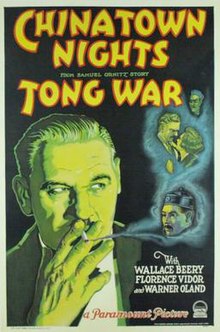Chinatown Nights (1929 film)
| Chinatown Nights | |
|---|---|
 | |
| Directed by | William A. Wellman |
| Written by |
|
| Produced by | David O. Selznick |
| Starring | |
| Cinematography | Henry W. Gerrard |
| Edited by | Alyson Shaffer |
| Music by |
|
| Distributed by | Paramount Pictures |
Release date |
|
Running time | 83 minutes |
| Country | United States |
| Language | English |
Chinatown Nights, also known as Tong War, is a 1929[1] film starring Wallace Beery and begun as a silent film then finished as an all-talking sound one via dubbing. Directed by William A. Wellman and released by Paramount Pictures, Chinatown Nights also stars Florence Vidor, former wife of director King Vidor, who did not dub her own voice and quit the movie business immediately afterward, preferring not to work in sound films; her voice in Chinatown Nights was supplied by actress Nella Walker. The supporting cast includes Warner Oland as a Chinese gangster and Jack Oakie as a stuttering reporter. The movie was based upon the story "Tong War" by Samuel Ornitz.
Cast
[edit]- Wallace Beery as Chuck Riley
- Florence Vidor as Joan Fry (voice dubbed by Nella Walker)
- Warner Oland as Boston Charley
- Jack McHugh as the Shadow
- Jack Oakie as the Reporter
Wellman and the “shotgun mike”
[edit]During the filming of Chinatown Nights as a silent feature, Paramount abruptly stopped production. A dialogue script was quickly prepared and sound technicians and equipment arrived on the set so as to shoot the picture as a “talkie.”[2]
Film historian Scott Eyman reports that director Wellman clashed with the soundmen over the positioning of the overhead microphone during a tracking shot involving Wallace Berry and Florence Vidor. Technicians insisted that the actors stop whenever they spoke, interrupting the camera motion. Frustrated, Wellman commandeered the microphone, and holding it in his lap on the tracking platform, aimed it at the actors and proceeded with the shoot; the audio proved satisfactory.[3]
Eyman notes that Wellman “received no credit for the innovation” of the “ “shotgun microphone”, but utilized this method with “extraordinary virtuosity” in the boxing drama The Man I Love (1929).[4]
See also
[edit]Footnotes
[edit]- ^ "AFI|Catalog". catalog.afi.com. Retrieved February 12, 2023.
- ^ Eyman, 1997 p. 227-228
- ^ Eyman, 1997 p. 228
- ^ Eyman, 1997 p. 228-229
Sources
[edit]- Eyman, Scott. 1997. The Speed of Sound: Hollywood and the Talkie Revolution, 1926-1930. Simon & Schuster, New York. ISBN 0-684-81162-6
External links
[edit]- Chinatown Nights at the AFI Catalog of Feature Films
- Chinatown Nights at IMDb
- Chinatown Nights at the silentera.com database
Text is available under the CC BY-SA 4.0 license; additional terms may apply.
Images, videos and audio are available under their respective licenses.
